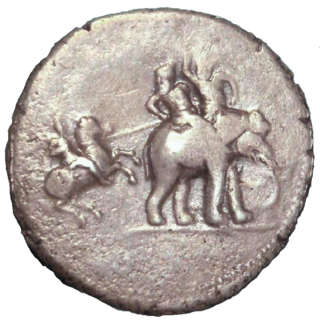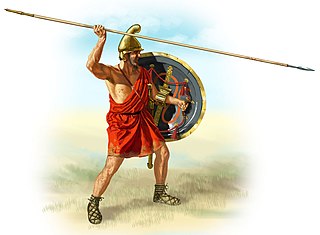
Porus or Poros was an ancient Indian king whose territory spanned the region between the Jhelum River (Hydaspes) and Chenab River (Acesines), in the Punjab region of what is now India and Pakistan. He is only mentioned in Greek sources. Said to be a warrior with exceptional skills, Porus unsuccessfully fought against Alexander the Great in the Battle of the Hydaspes. In the aftermath, an impressed Alexander not only reinstated him as his satrap but also granted him dominion over lands to the south-east extending as far as the Hyphasis (Beas). Porus reportedly died sometime between 321 and 315 BC.

Perdiccas was a Macedonian general, successor of Alexander the Great, and regent of Alexander's empire after his death. When Alexander was dying, he entrusted his signet ring to Perdiccas. Initially the most pre-eminent of the successors, Perdiccas effectively ruled Alexander's increasingly unstable empire from Babylon for three years, until his assassination, as the kings he ruled for were incapable.

The Battle of Issus occurred in southern Anatolia, on 5 November 333 BC between the Hellenic League led by Alexander the Great and the Achaemenid Empire, led by Darius III. It was the second great battle of Alexander's conquest of Asia, and the first encounter between Darius III and Alexander the Great. The battle resulted in the Macedonian troops defeating the Persian forces.

The Battle of Gaugamela, also called the Battle of Arbela, took place in 331 BC between the forces of the Army of Macedon under Alexander the Great and the Persian Army under King Darius III. It was the second and final battle between the two kings, and is considered to be the final blow to the Achaemenid Empire, resulting in its complete conquest by Alexander.

Antipater was a Macedonian general and statesman under the successive kingships of Philip II of Macedon and his son, Alexander the Great. In the wake of the collapse of the Argead house, his son Cassander would eventually come to rule Macedonia as a king in his own right.

The Wars of the Diadochi or Wars of Alexander's Successors were a series of conflicts fought between the generals of Alexander the Great, known as the Diadochi, over who would rule his empire following his death. The fighting occurred between 322 and 281 BC.

Craterus or Krateros was a Macedonian general under Alexander the Great and one of the Diadochi. Throughout his life, he was a loyal royalist and supporter of Alexander the Great.

The Battle of the Hydaspes also known as Battle of Jhelum, or First Battle of Jhelum, was fought between Alexander the Great and Porus in May of 326 BCE. It took place on the banks of the Hydaspes River in what is now the Punjab province of Pakistan, as part of Alexander's Indian campaign. In what was possibly their most costly engagement, the Macedonian army secured a decisive victory over the Pauravas and captured Porus. Large areas of Punjab were subsequently absorbed into the Macedonian Empire; Porus was reinstated as the region's ruler after Alexander, having developed a newfound respect for the fierce resistance put up by Porus and his army, appointed him as a satrap.
Meleager was a Macedonian officer who served under Alexander the Great. He was among the generals that accompanied the king in his quest to conquer Asia Minor, and was one of the most experienced among them. The only military figure who was more experienced than Meleager was the Macedonian general Antipater, who remained in Macedon during Alexander's entire Asian campaign.

The Battle of the Granicus in May 334 BC was the first of three major battles fought between Alexander the Great of Macedon and the Persian Achaemenid Empire. The battle took place on the road from Abydus to Dascylium, at the crossing of the Granicus in the Troad region, which is now called the Biga River in Turkey. In the battle Alexander defeated the field army of the Persian satraps of Asia Minor, which defended the river crossing. After this battle, the Persians were forced on the defensive in the cities that remained under their control in the region.

The Companions were the elite cavalry of the Macedonian army from the time of King Philip II of Macedon, achieving their greatest prestige under Alexander the Great, and regarded as the first or among the first shock cavalry used in Europe. Chosen Companions, or Hetairoi, formed the elite guard of the king (Somatophylakes).

A hypaspist is a squire, man at arms, or "shield carrier". In Homer, Deiphobos advances "ὑπασπίδια" or under cover of his shield. By the time of Herodotus (426 BC), the word had come to mean a high status soldier as is strongly suggested by Herodotus in one of the earliest known uses:
Now the horse which Artybius rode was trained to fight with infantrymen by rearing up. Hearing this, Onesilus said to his hypaspist, a Carian of great renown in war and a valiant man ...

The Kingdom of Macedon possessed one of the greatest armies in the ancient world. It is reputed for the speed and efficiency with which it emerged from Greece to conquer large swathes of territory stretching from Egypt in the west to India in the east. Initially of little account in the Greek world, it was widely regarded as a second-rate power before being made formidable by Philip II, whose son and successor Alexander the Great conquered the Achaemenid Empire in just over a decade's time.

The Partition of Babylon was the first of the conferences and ensuing agreements that divided the territories of Alexander the Great. It was held at Babylon in June 323 BC. Alexander’s death at the age of 32 had left an empire that stretched from Greece all the way to India. The issue of succession resulted from the claims of the various supporters of Philip Arrhidaeus, and the as-of-then unborn child of Alexander and Roxana, among others. The settlement saw Arrhidaeus and Alexander’s child designated as joint kings with Perdiccas serving as regent. The territories of the empire became satrapies divided between the senior officers of the Macedonian army and some local governors and rulers. The partition was solidified at the further agreements at Triparadisus and Persepolis over the following years and began the series of conflicts that comprise the Wars of the Diadochi.

The Mallian campaign was conducted by Alexander the Great from November 326 to February 325 BC, against the Mallians of the Punjab. Alexander was defining the eastern limit of his power by marching down-river along the Hydaspes to the Acesines, but the Malli and the Oxydraci combined to refuse passage through their territory. Alexander sought to prevent their forces meeting, and made a swift campaign against them which successfully pacified the region between the two rivers. Alexander was seriously injured during the course of the campaign, almost losing his life.

The Cophen campaign was conducted by Alexander the Great in the Kabul Valley between May 327 BC and March 326 BC. It was conducted against the Aspasioi, the Guraeans, and the Assakenoi tribes in the Kunar valley of Afghanistan, and Panjkora (Dir) and Swat valleys in what is now Khyber Pakhtunkhwa, Pakistan. The goal of the campaign was to secure the Macedonian line of communications so that the Macedonian army could proceed into India proper.

The Battle of the Hellespont took place in 321 or 320 BC between the armies of Craterus and Neoptolemus against Eumenes. It was part of the wars between Alexander's successors. Eumenes and Neoptolemus were sent by Perdiccas to prevent Craterus crossing the Hellespont into Asia, but Neoptolemus deserted to join Craterus. Eumenes won the battle, and both Craterus and Neoptolemus were killed.

The Macedonian phalanx was an infantry formation developed by Philip II from the classical Greek phalanx, of which the main innovation was the use of the sarissa, a 6-metre pike. It was famously commanded by Philip's son Alexander the Great during his conquest of the Achaemenid Empire between 334 and 323 BC. The Macedonian phalanx model then spread throughout the Hellenistic world, where it became the standard battle formation for pitched battles. During the Macedonian Wars against the Roman Republic, the phalanx appeared obsolete against the more manoeuvrable Roman legions.
The military tactics of Alexander the Great have been widely regarded as evidence that he was one of the greatest generals in history. During the Battle of Chaeronea, won against the Athenian and Theban armies, and the battles of Granicius and of Issus, won against the Achaemenid Persian army of Darius III, Alexander employed the so-called "hammer and anvil" tactic. However, in the Battle of Gaugamela, the Persians possessed an army vastly superior in numbers to the Macedonian army. This tactic of encirclement by rapid shock units was not very feasible. Alexander had to compose and decide on an innovative combat formation for the time; he arranged his units in levels; he pretended to want to encircle the enemy in order to better divide it and thus opened a breach in its defensive lines.













